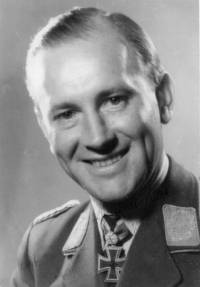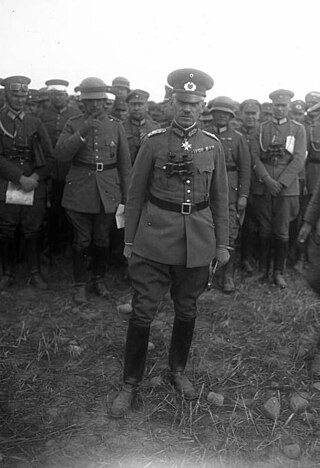
Robert Ritter von Greim was a German Generalfeldmarschall and First World War flying ace. In April 1945,in the last days of World War II in Europe,Adolf Hitler appointed Greim commander-in-chief of the Luftwaffe after Hermann Göring had been dismissed for treason. He is the last person ever promoted to field marshal in the German armed forces. After the surrender of Nazi Germany in May 1945,Greim was captured by the Allies. He committed suicide in an American-controlled prison on 24 May 1945.

Hans-Jürgen Bernard Theodor von Arnim was a German general in the Wehrmacht during World War II who commanded several armies. He was a recipient of the Knight's Cross of the Iron Cross.

Friedrich Karl Albert Dollmann was a German general during World War II who commanded the 7th Army during the Invasion of France and the early phases of the Allied invasion of Normandy until his death in June 1944.

Friedrich August Eberhard von Mackensen was a German general and war criminal during World War II who served as commander of the 1st Panzer Army and the 14th Army. Following the war,Mackensen stood trial for war crimes before a British military tribunal in Italy where he was convicted and sentenced to death for his involvement in the Ardeatine massacre,in which hundreds of Italian civilians and political prisoners were shot. The sentence was later commuted and Mackensen was released in 1952. He died in West Germany in 1969.

Max-Hellmuth Ostermann was a Luftwaffe fighter ace during World War II. A flying ace or fighter ace is a military aviator credited with shooting down five or more enemy aircraft during aerial combat. He is credited with 102 enemy aircraft shot down claimed in over 300 combat missions. The majority of his victories were claimed over the Eastern Front with eight claims over the Western Front and one over Belgrade. Ostermann was of such short height that wooden blocks had to be attached to his rudder pedals for him to engage in tight turning aerial combat.

Johannes Wiese was a German Luftwaffe pilot during World War II,a fighter ace credited with 133 enemy aircraft shot down in 480 combat missions. He claimed all of his victories over the Eastern Front,including over 50 Ilyushin Il-2 Shturmovik ground attack aircraft.

Hermann Hogeback was a German bomber pilot during the Nazi era. He flew more than 100 operational sorties during the Spanish Civil War and 500 during World War II and was a recipient of the Knight's Cross of the Iron Cross with Oak Leaves and Swords of Nazi Germany. Hogeback's last service position was commander of the 6th Bomber Wing.

Günther Krappe was a German officer in the Second World War. He commanded the 61st Infantry Division.

General der Flieger was a General of the branch rank of the Luftwaffe in Nazi Germany. Until the end of World War II in 1945,this particular general officer rank was on three-star level (OF-8),equivalent to a US Lieutenant general.
Major General Carl-August von Schoenebeck began his career in the Baden Leib-Grenadier Regiment in 1915. He transferred to the Luftstreitkräfte in 1916. After training,he served with the artillery cooperation unit FA (A) 203. His subsequent service in fighters (e. g. Jasta 11 earned him credit for eight confirmed aerial victories and a number of decorations,as well as the command of Jasta 33 while still a leutnant.

Hans-Georg von Seidel was a German military leader who served in the German Army during World War I and in the Luftwaffe during World War II. Seidel was promoted to the rank of General der Flieger.

Maximilian Fretter-Pico was a German general during World War II. He was a recipient of the Knight's Cross of the Iron Cross with Oak Leaves of Nazi Germany.

Helmut Haugk was a Luftwaffe ace and recipient of the Knight's Cross of the Iron Cross during World War II. The Knight's Cross of the Iron Cross was awarded to recognise extreme battlefield bravery or successful military leadership. Haugk claimed 18 aerial victories in more than 440 flights.

Rüdiger von Heyking was a German officer and Lieutenant General of the Luftwaffe during World War II.

General der Luftwaffe was a General of the branch rank of the Deutsche Luftwaffe in Nazi Germany. Until the end of World War II in 1945,this particular general officer rank was on three-star level (OF-8),equivalent to a US Lieutenant general.
Wilhelm Haehnelt was a Luftwaffe General der Flieger in World War II.
Gerhard Glokke was a German general.

Walter Surén was a general officer with the final rank –General der Luftnachrichtentruppe of the Deutsche Luftwaffe in Nazi Germany. Until the end of WW2 in 1945,this particular general officer rank was on three-star level (OF-8),equivalent to a US Lieutenant general.

Theodor Rudolph Carl Clewing was a German operatic tenor/heldentenor,stage and film actor,composer of the song Alle Tage ist kein Sonntag and professor at the Universität der Künste Berlin.

Otto Hasse was a German General of the Infantry and from 1923 to 1925 Chief of the Truppenamt.
















